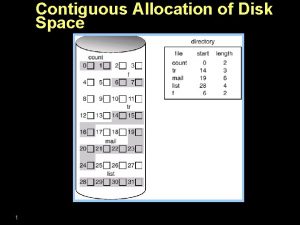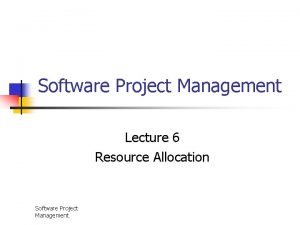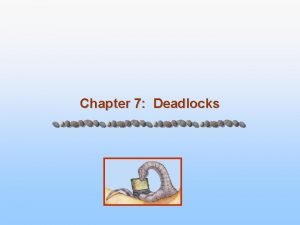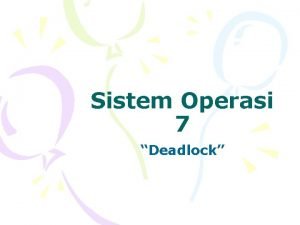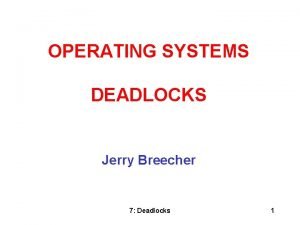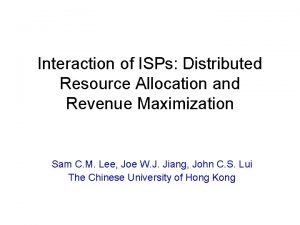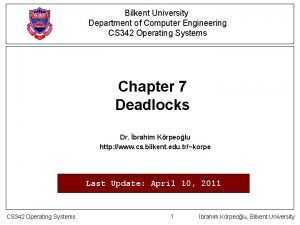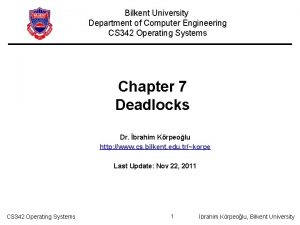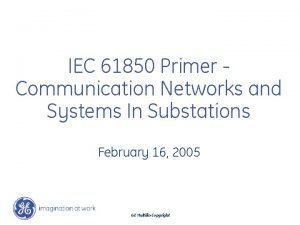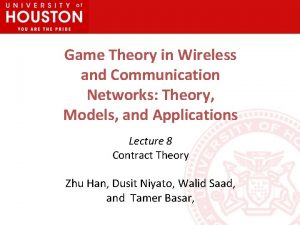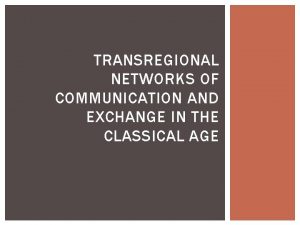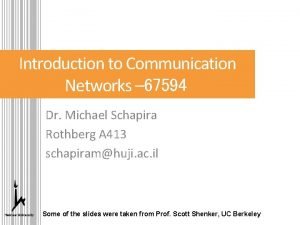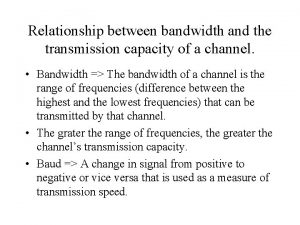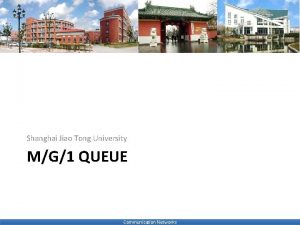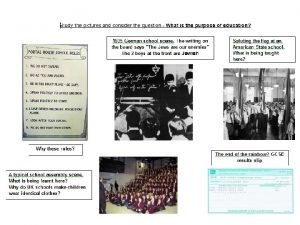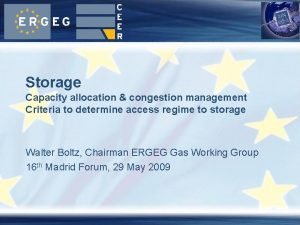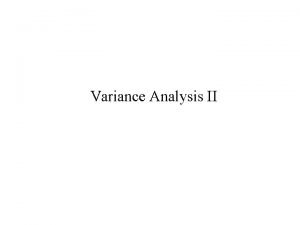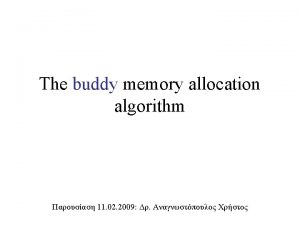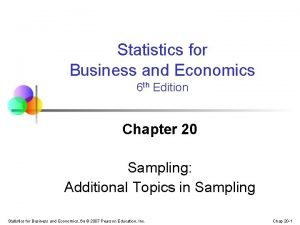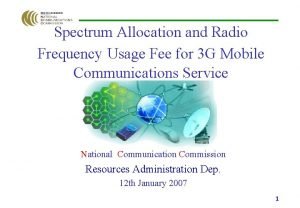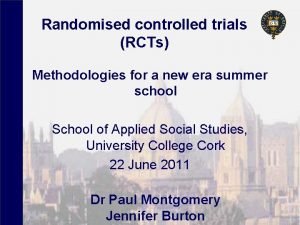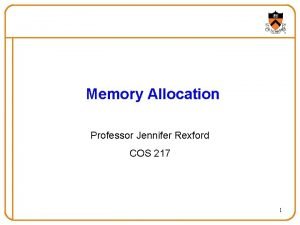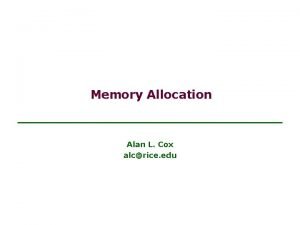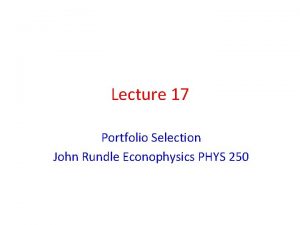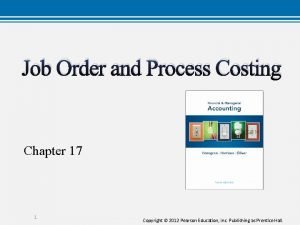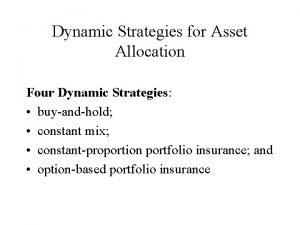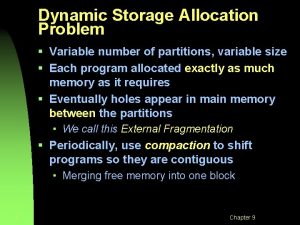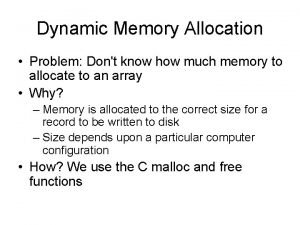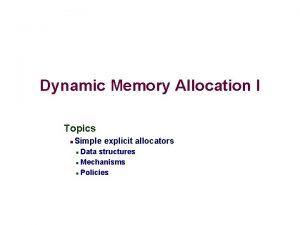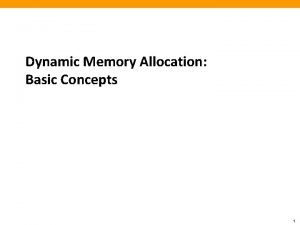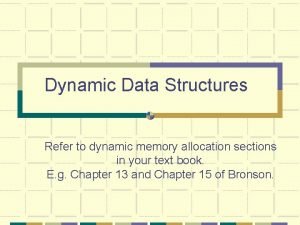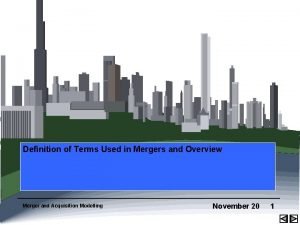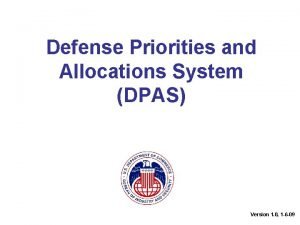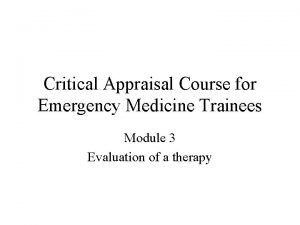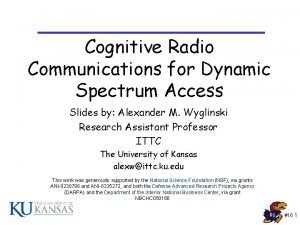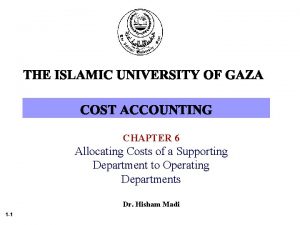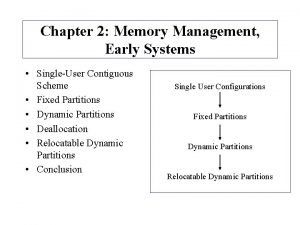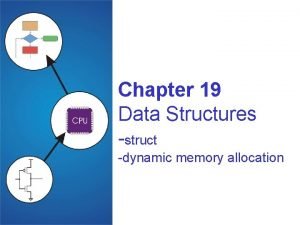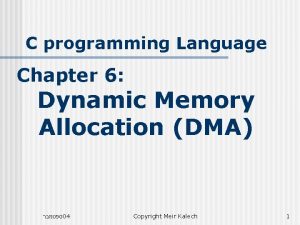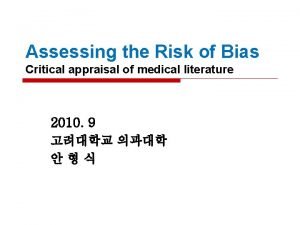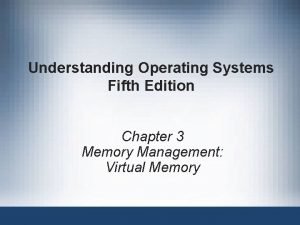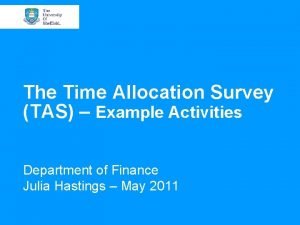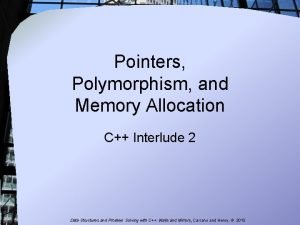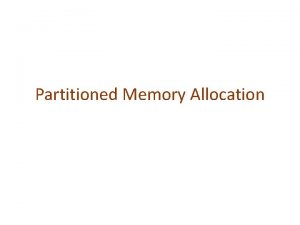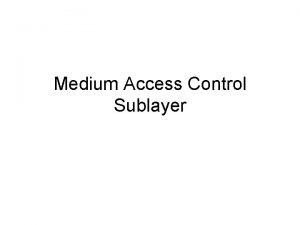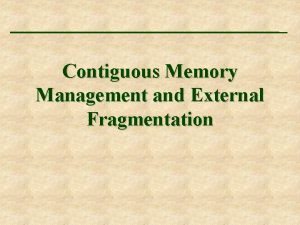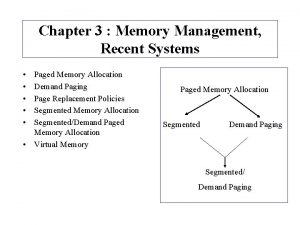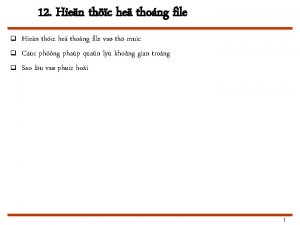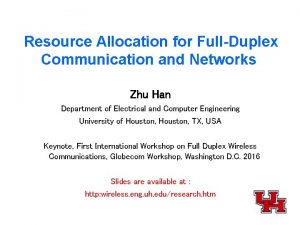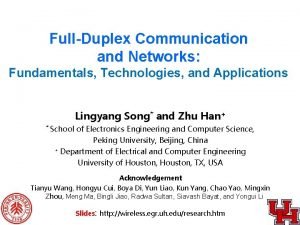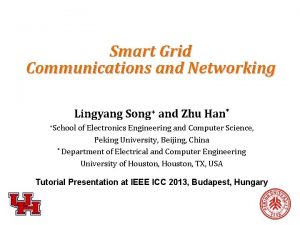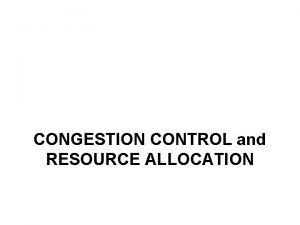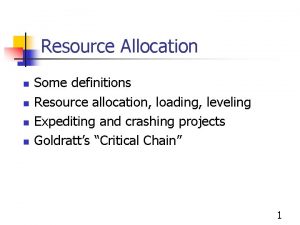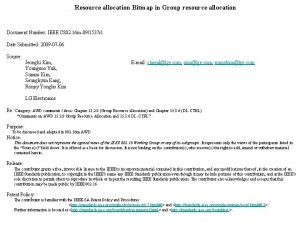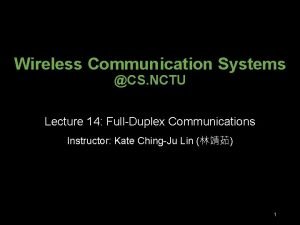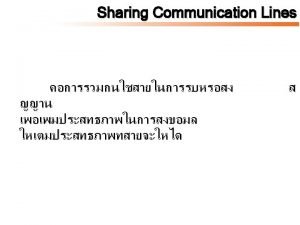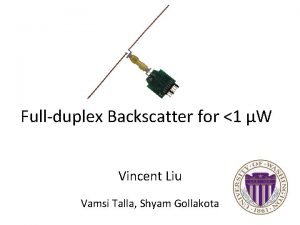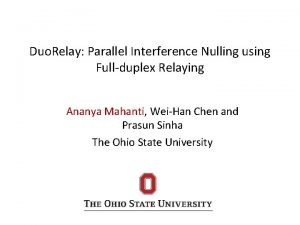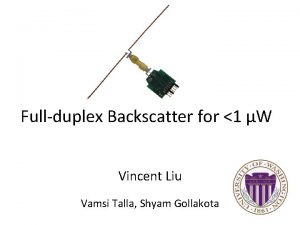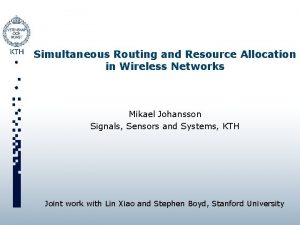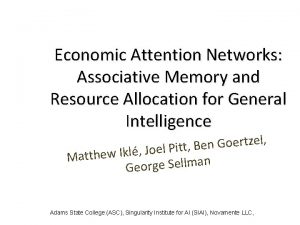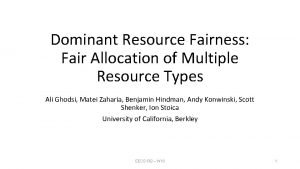Resource Allocation for FullDuplex Communication and Networks Lingyang




































































































































































- Slides: 164

Resource Allocation for Full-Duplex Communication and Networks Lingyang Song* and Zhu Han+ * School of Electronics Engineering and Computer Science, Peking University, Beijing, China + Department of Electrical and Computer Engineering University of Houston, TX, USA Slides are available at : http: //wireless. egr. uh. edu/research. htm 1

Table of Content • Basic of Full-duplex Communications • Resource Allocation and Game Theoretical Study • Applications • Conclusions 2/163

Table of Content • Basic of Full-duplex Communications – Background – Self-interference cancellation – Application scenarios – Research problems – Working Assumptions – Signal and interference model – Full-duplex and multiplexing switching – Full-duplex MIMO communication – Full-duplex cooperative communication – Full-duplex heterogeneous networks 3/163

History of Mobile Communications 1900: Famous patent No. 7777, "tuned or syntonic telegraphy" 1900: Marconi's Wireless Telegraph Company Limited founded 1901: Transmitting the first wireless signals across the Atlantic between Poldhu, Cornwall, and St. John's, Newfoundland, a distance of 2100 miles. 1909: The Nobel Prize in Physics 4/163

A Market Needs both Technology and Application From data … to voice … to everything 5/163

Standardization Facilitates Technology Evolution • Each new evolution builds on the established market of the previous 1995 2000 2005 2010 • Backwards-compatible evolution • But larger technology steps require revolutions: From TDMA: to CDMA: to OFDMA: 6/163 2015

Future Wireless Challenges Explosion of data traffic VS Limited spectrum Source: Irish Regulator Com. Reg Announces Results of its 4 G Spectrum Auction Fig. 2 Results Index of Irish 4 G Spectrum Auction Fig. 1 Cisco Visual Networking Global Mobile Data Traffic Growth 7/163

KPIs Key Performance Indicators (KPIs) 20. . . 10 Gbps 1000 X Capacity 10 X User Rate Anywhere 10 X Peak Data Rate (Traffic and Connections) (100 M-1 Gbps) (10+Gbps) 6 Key Requirements 1000 X Energy&Cost Reduce 10 X Low Latency, High reliability 8/163 5 -10 X Spectrum Efficiency

Future Wireless Challenges: Analysis Signal to Noise plus Interference Radio Scaled Transmission Time Capacity:C = N * W * T * log(1 + SINR) No. of APs Bandwidth 9/163

Evolution (1) Evolutions Ultra Dense Deployment: LTE-Hi and Further Evolution Cell Edge User Experience: Coordination and Comp, Advanced IC More Scenarios and Use Case: Flexible Network and High M 2 M, D 2 D, V 2 X Reliability: Mobile Relay, UE Relay, MAC direct, 10/163 Link Efficiency: Massive MIMO, 3 D-BF, Full-duplex Smart Network: Service & Environment Awareness SON; Multi-Radio/Multi-RAT SON

1000 X Capacity 1000 X Capacity 5 G Requirement rk o etw N y t i ns e D ltra 10 Gbps/Km 2 U ma i/S H E LT 1 Gbps/Km 2 10 Mbps/Km 2 2 G 3 G 4 G l ll-Cel 1000 X Mobile Data (100 -1000 Gbps/Km 2) Full-duplex, mm. Wave 1000 X Connections M 2 M Optimization 11/163 (1 M Connections/Km 2)

10 X Peak Rate 10 X Peak Rate 5 G Requirement 1 Gbps x, e l up D ll MA O N Fu Full-duplex communication can be one possible trum c e p Immediately Downloading h S 10 Mbps g i H a r solution to meet the future wireless challenges Ult 100 Kbps 2 G 3 G 4 G Ultra-Dense Network High Spectrum, mm. Wave 12/163 3 D-UHDTV 10 Gbps Peak Rate

Background of Full-Duplex Techniques • Traditional half duplex: using orthogonal resources – Time-division duplex – Frequency-division duplex Fig. 3 Time-division duplex Fig. 4 Frequency-division duplex • Problems Spectral – The orthogonal resources are allocated for reception and loss transmission. • Solutions Full-duplex Comms – The same resources are allocated for reception and transmission 13/163

Full Duplex Introduction • A full duplex system allows communication at the same time and frequency resources. : Signal of interest : Self interference Fig. 5 Full duplex communication • Advantages – High spectral efficiency • Same time & same frequency band – Low cost • Readily use the existing MIMO radios • Hardware advancement, etc 14/163

Main Challenges Received Signal of interest signal • Traditional Challenges – Very large self interference • 50 -110 d. B larger than signal of interest • Depending on inter-node distance – ADC is the bottleneck • Limited dynamic range: saturation distortion. • Limited precision: signal of interest is less than noise. – For 12 bit ADC, INR(d. B) > SNR(d. B) + 35 d. B implies self interference is too strong • Need to reduce interference before ADC 15/163 Self interference Fig. 6 Very large Self interference Fig. 7 Signal after quantization

Self-interference Cancellation • Self interference channel • Passive propagation suppression – Design antennas to increase propagation loss of h. I • Active cancelation – Active analog cancelation • Cancel interference through analog part – Active digital cancelation • Cancel interference in the baseband 16/163

Passive Propagation Cancellation • Antenna placement – Separation d between TX and RX Fig. 7 Antenna separation – Place antennas at opposite sides of the device • Directional antenna – Used in full-duplex relays Fig. 8 Device cancellation Fig. 9 Directional antenna 17/163

Active Analog Cancelation (1) • Objective is to achieve exact 0 at the Rx antenna – Cancellation path = negative of interfering path • These techniques need analog parts Pre-mixer Post-mixer 18/163

Active Analog Cancelation (2) Post-mixer Pre-mixer Post-mixer x DAC ADC 19/163

Active Digital Cancelation • Conceptually simpler – requires no new “parts” • Two-step cancellation: – Estimate the self residual interference channel h. RI through training symbols – Cancel h. RIx[n] at baseband • Useless if interference is too strong (ADC bottleneck) 20/163

Main Application Scenarios • Full-Duplex Distributed Communication Systems – Two-node bi-directional MIMO system • Centralized Full-Duplex Communication Systems – Full-duplex relay network • DF relay • AF relay • Two-way relay – Full-duplex wireless network • FD cellular network 21/163 • FD Het. Net

Research Problems • Two nodes bidirectional full-duplex systems – – Self-interference channel estimation Self-interference cancellation Achievable sum rate bounds Optimal power allocation • Full-duplex MIMO systems – Adaptive Switching – Antenna selection – Interference-aware beamforming • Full duplex cooperative systems: hidden terminal problem – – Full duplex AF/DF relay design Hybrid full duplex/half duplex relay Node selection: relay/antenna selection Antenna selection • Full duplex cellular/Het. Net network – Distributed full duplex, use side-channel to cancel interference 22/163 – Radio resources and users allocation

Working Assumptions • Residual self interference after cancelation techniques – Rayleigh fading (or Rican fading) – Gaussian noise – Perfectly eliminated • Distortion caused by limited dynamic range – Gaussian • Consider it as Gaussian noise for lower bound – Ignored • residual self interference is small enough • Imperfect CSI – Estimation error of communication channel – Estimation error of self-interference channel 23/163

Full-Duplex Communication: Signal Model • It presents a two-node full-duplex system, where each node – transmits signal xi, i = 1, 2 to the other – has one antenna for transmission with another for reception – concurrently transmit sand receive s the signals at the same frequency carrier and time interval 24/163

Full-Duplex Communication: Signal Model • Each source receives a combination of the signal transmitted by the other source, the RSI, and noise • The instantaneous SINR at source i’s receiver for full-duplex is • The RSI depends largely on the transmit power, and also varies due to the practical constraint. • The values of |hji|2, |hii|2, and Ps have strong impact on SINR, which will affect the system performance significantly. • Thus, proper resource allocation that can further reduce the effects of residual self-interference is crucial for full-duplex communication. 25/163

Full-Duplex MIMO Communication • Resource Allocation Problems – Power control – Interference-aware beamforming – Switching between full-duplex and multiplexing – Antenna selection 26/163

Full-duplex and Spatial Multiplexing Switching Full duplex Spatial Multiplexing • Received signal at node I by full duplex Signal of interest Residual self interference 27/163 : Average SNR : Average INR

MIMO Spatial Multiplexing (1): System Model • MIMO: Strong candidate for the future wireless standards – Higher data rate – Better protection against errors by utilizing diversity • At the transmitter: sptial multiplexing – FEC can be applied before the data gets demulplexed. • At the receiver: ZF, MMSE, etc, can be used to reover the signals – M<=N, for large capacity 28/163

MIMO Spatial Multiplexing (2): Signal Model • Full duplex & Spatial multiplexing Full duplex Spatial Multiplexing – Received signal at node I by spatial multiplexing : a white random matrix : the correlation at the transmitter separable correlation model : the correlation at the receiver e. g. 29/163

Full-duplex and MIMO Communications • Two limitations – Full duplex (FD): Self interference – Spatial multiplexing (SM): Spatial correlation FD Adaptive switch Self interference Criterion ? SM Spatial correlation • Optimal switching – Maximize the ergodic capacity • Suboptimal switching – Maximize the asymptotic capacity at high SNR 30/163

Optimal Switching Criterion (1) • Maximize the ergodic capacity – Ergodic capacity of full duplex Fig. Full duplex is the exponential integral function of the first order 31/163

Optimal Switching Criterion (2) • Maximize the ergodic capacity – Ergodic capacity of spatial multiplexing Spatial multiplexing : eigenvalues of the transmit and receive correlation matrixes 32/163

Optimal Switching Criterion (3) • Capacity of the optimal switching criterion – Switched by the exact switching threshold • Optimal but very complicated 33/163

Suboptimal Switching Criterion (1) • Maximize the asymptotic capacity at high SNR – Asymptotic Performance • Full duplex High-SNR capacity for FD without interference Capacity degradation caused by the self interference • Spatial multiplexing High-SNR capacity for independent fading SM Capacity degradation due to the correlations 34/163

Suboptimal Switching Criterion (2) • Combining the asymptotic capacities Relative degradation of SM Relative degradation of FD – Consider the exponential correlation model Determined by and Independent of 35/163

Suboptimal Switching Criterion (3) • Maximize the asymptotic threshold at high SNR – The system selects the mode with better performance at high SNR. – It can be used at low SNR, with a bearable capacity loss. – The capacity loss decreases with the growth of SNR. • Suboptimal, but low-complexity 36/163

Some Results Ergodic capacities for FD, SM and the optimal switch versus INR 37/163 Ergodic capacities for FD, SM and the optimal, suboptimal switching

Conclusions • To better understand the FD system, we have made comparisons with the HD systems by spatial-multiplexing. – When the self interference is severe, the SM mode outperforms the FD mode; – When the spatial correlation is large, the FD mode is a better selection; • We proposed an adaptive switching scheme between FD and SM to improve system capacity by two criteria: – One is based on the exact threshold of the ergodic capacity of the two modes, optimal but complex. – The other is suboptimal and switched by an approximate threshold at high SNR with a reduced complexity. 38/163

Transmit-Receive Antenna Pair Selection • A novel transmit-receive antenna pair selection scheme is proposed for bidirectional full duplex (FD) communications between two nodes, where each node is equipped with two antennas, used for either transmission or reception. • One transmit and receive antenna combination is selected from four possible pairs based on two system performance criteria: • Maximum sum-rate and • Minimum symbol-error-rate ① Mingxin Zhou, Hongyu Cui, Lingyang Song, and Bingli Jiao, “Transmit-Receive Antenna Pair Selection in Full Duplex Systems, ” IEEE Wireless Communications Letters, vol. 3, no. 1, pp. 34 -37, Feb. 2014. ② Mingxin Zhou, Lingyang Song, Yonghui Li, and Xuelong Li, “Simultaneous Bidirectional Link Selection in Full Duplex MIMO Systems, ” to appear, IEEE Transactions on Wireless Communications. 39/163

Selection Criterion: Max-Sum Rate • Maximum sum-rate criterion where • An upper bound is calculated as 40/163

Selection Criterion: Min-Sum SER • Minimum symbol-error-rate criterion – An approximate min-max criterion – A lower bound is calculated as 41/163

Some Results Analytical and simulated sum rate versus transmit power 42/163 Analytical and simulated SER versus transmit power

Conclusions • We have introduced antenna selection into FD systems, and proposed two effective selection approaches, i. e. Max. SR and Min-SSER – to obtain maximum sum rate and minimum sum SER, respectively. • We have also shown that the interference cancelation capability is a key factor to affect the AS performance – the selection gains increase with the decrease of the residual self interference. • Furthermore, the sum rate has an upper bound – the sum SER gain always increases with the decrease of residual interference. 43/163

Full-Duplex Cooperative Communication Full-duplex cooperative relaying Full-duplex two-way relaying • Resource allocation problems – Adaptive switching – Power control – Relay and antenna selection – Radio resource allocation 44/163

Why Cooperation? Mobile Station (MS) 2 Base station (BS) Why Cooperation in wireless networks? • Increased coverage Mobile Station (MS) 1 • Reduced transmission power • Cooperative diversity • Cooperative coding gain 45/163

Cooperative Communications User 1 data User 2 data t 1 Non cooperation t 2 Cooperation Applications o Cellular networks o Wireless sensor networks o Wireless Ad Hoc networks 46/163 Time

2 -Hop Relay Networks Source Destination Relay 2 -hop relay network with a direct link Two phases transmission: I: Source broadcasts to relay and destination II: Relay forwards to the destination 47/163

Relaying Protocols • • Amplify and forward (AF) Decode and forward (DF) Adaptive Relaying Protocol (ARP) Compress and forward (CF) Source Destination Relay 48/163

Amplify and Forward (AF) • Relay is used as an Amplifier • Amplify both signal and noise 49/163

Decode and Forward (DF) • Introduce error propagation when decoding errors occur • DF is superior to AF when the S-R channel quality is good enough because DF can eliminate the effect of noise • AF is superior to DF when the S-R channel quality is poor because DF will introduce serious error propagation 50/163

Full-Duplex Cooperative Relaying • It illustrates a simplest FD relay network consisting of one HD source, one HD destination, and one FD cooperative relay node. • Both the source and relay nodes use the same timefrequency resource and the relay nodes work in the FD mode with two antennas. Full-duplex cooperative relaying The communication process • The source transmits signals to both the FD relay and destination; • At the same time the FD relay forwards the signals received in the previous time slots to the destination. 51/163

Joint Antenna and Relay Selection • A joint relay and antenna selection scheme is studied in general full-duplex (FD) relay networks. • The system has one source, one destination and N FD amplify-and-forward relays. • Each FD relay is equipped with two antennas, one for receiving and one for transmitting. ① Kun Yang, Hongyu Cui, Lingyang Song, and Yonghui Li, “Joint Relay and Antenna Selection for Full. Duplex AF Relay Networks, ” IEEE International Conference on Communications, Sydney, Australia, Jun. 2014. ② Kun Yang, Hongyu Cui, Lingyang Song, and Yonghui Li, “Efficient Full-Duplex Relaying with Joint Antenna-Relay Selection and Self-Interference Suppression, ” to appear, IEEE Transactions on Wireless 52/163 Communications.

Selection Criteria (1) • Antenna selection criterion: – Assumption: each antenna of the relay is able to transmit/receive the signal. – The relay configures the Tx/Rx antenna via the channel state information. – Maximum end-to-end SINR criterion Mode 1: Rx antenna T 1 and Tx antenna T 2 Mode 2: Rx antenna T 2 and Tx antenna T 1 53/163

Selection Criteria (2) • Joint antenna and relay selection scheme – Maximum end-to-end SINR criterion – 2 N candidate configurations 54/163

Some Results Average SER of AS-ORS scheme versus the transmit power 55/163 Average SER of AS-ORS scheme versus the transmit power

Conclusions • We proposed a joint relay and antenna selection scheme for the multiple FD relay networks with one source, one destination and N FD relays. • By adaptively selecting the Tx and Rx antennas at each FD relay node, the proposed scheme can achieve an additional spatial diversity at the destination. • Thus, a significant performance improvement than the conventional relay selection scheme with fixed Tx and Rx antenna configuration at the relay. • Comparatively, the RAMS scheme achieves: – twice of the diversity order at low to medium SNRs and – a much lower error floor at high SNRs. 56/163

Two-way Relaying Networks (1) • Conventional Bi-Directional Relay Protocal 57/163

Two-way Relaying Networks (2) • Decode-and-Forward Bi-Directional Relay Protocal 58/163

Two-way Relaying Networks (3) • Amplify-and-Forward Bi-Directional Relay Protocal Analog Network Coding 59/163

Full-Duplex Two-Way Relaying Full-duplex two-way relaying • The FD two-way relay system consists of two sources, and one relay node and all nodes work in the FD mode with two antennas, one for transmission and one for reception. • The direct link between two source nodes does not exist due to the shadowing effect. The communication process • Two source nodes transmit signals to the relay node, while receiving the signal sent from the relay node at the same time • The relay broadcasts the signals received in the previous time slot to both source nodes and meanwhile receiving the signals from the 60/163 sources.

Two-way Full-Duplex Relay Selection • We analyze and optimize the two-way FD relay system using amplify and-forward protocol, when the multi-relay scenario is considered. • The optimal relay selection scheme in maximizing the effective signal-to-interference and noise ratio is proposed, which significantly improves the system performance than a single relay network. Hongyu Cui, Lingyang Song, and Bingli Jiao, “Relay Selection for Two-Way Full Duplex Relay Networks with Amplify-and-Forward Protocol, ” IEEE Transactions on Wireless Communications, 61 vol. 13, no. 7, pp. 3768 -3876, Jul. 2014. 61/163

Problem Formulation The received signal at the relay is The amplified signal of the relay satisfies – where The received signal at the source is Therefore 62/163

Selection Criteria The received SINR is It can be verified that the optimal selection criteria is equivalent to 63/163

Some Results 64/163

Conclusions • The multiple-relay scenario is considered – the two-way full duplex relay of AF protocol was analyzed and optimized. – the optimal power allocation and the optimal choice of duplex mode for the two-way relay are obtained in minimizing the outage probability. • Results reveal that the two-way FD relay has the better performance than two-way HD relay, if the residual selfinterference is sufficiently small. 65/163

Full-Duplex Heterogeneous Networks • A FD-Het. Net consists of a single BS and multiple FAPs, all equipped with 2 antennas. • Each cell has multiple users that attempt to connect either to the BS or the FAPs. • Both BS and FAPs work in the FD mode. Full-Duplex Heterogeneous Networks ① Radwa Sultan, Lingyang Song, and Zhu Han, “Impact of Full Duplex on Resource Allocation for Small Cell Networks, ” The IEEE Global Conference on Signal and Information Processing (Global. SIP), December 35, 2014. Atlanta, Georgia, USA. ② Radwa Aly Sultan, Lingyang Song, Karim G Seddik, Yonghui Li, and Zhu Han, “Mode Selection, User Pairing, Subcarrier Allocation and Power Control in Full-Duplex OFDMA Het. Nets, ” IEEE ICC 2015 - 4 th 66/163 International Workshop on Small Cell and 5 G Networks (Small. Nets) , London, UK, June 2015.

Results and Conclusions • Both uplink and downlink users are connected to the BS; • The uplink user is connected to the BS but the downlink user is connected to the FAP; • Both the uplink and downlink users are connected to the FAP; • The uplink user is connected to the FAP and the downlink user is 67/163 connected to the BS.

Resource Allocation Problem Summary (1) • Mode Switch – Half-duplex radio • Due the limited size of transmitter and receiver, many wireless communication systems suffer from the spatial correlation which degrades the performance gain of HD mode. – Full-duplex radio • It allows a node to send and receive signals at the same time in the same frequency band. • However, it is practically impossible to have perfect self interference cancelation, and thus, the amount of RSI greatly affects the performance of FD system. • As a result, in some scenarios, the HD mode may outperform the FD mode for certain RSI values. • This motivates the adaptive mode switching between the FD and HD modes based on the RSI and channel conditions to maximize the ergodic capacity. 68/163

Resource Allocation Problem Summary (2) • Power Control – due to RSI, power control algorithm needs to be properly redesigned in order to maximize system performance of all users. • FD-MIMO: – The antennas at the FD node are divided into transmit and receive antenna sets – Water-filling power allocation can be applied at the transmit antenna set to maximize the sum rate based on individual power constraint. • FD-Relay: – In FD-Relay networks with individual power constraint at each relay, the relayed signals are corrupted by the RSI, – Power allocation can be considered to reduce RSI subject to total and individual power constraints 69/163

Resource Allocation Problem Summary (3) • Power Control – FD-OFDMA: for FD-OFDMA with one FD BS and HD multiple users, uplink (transmit) and downlink (receive) users are paired to communicate with FD BS at the same time. • The transmit power can be allocated at the BS side with total power constraint by splitting the power among all he subcarriers for different user pairs. • At the user side, power control needs to take into account the inter-user distance among the transmit-receiver user pair. – FD-Het. Net: • Similar to FD-OFDMA, the power control can be performed for the FD BS and femtocell access points (FAPs) and HD users in FD-Het. Net to optimize the network performance. • However, both the inter-cell interference and RSI need to be considered jointly in optimizing the overall network performance. 70/163

Resource Allocation Problem Summary (3) • Transmit Beamforming: – The robust transmit beamforming algorithms can improve the signal strength at the receiver side, – and meanwhile reduce the self interference subject to various design criteria. • FD-MIMO: the transmit antenna set at each FD nodes can perform beamforming to simultaneously transmit information and reduce the interference to its own received signals • FD-OFDMA: – The FD BS is equipped with multiple antennas, consisting of transmit and receive antenna sets, – while the users only operate in the HD transmission mode due to hardware constraint. – The BS can construct beamformer to support multiple users in the downlink while maximizing the received SNRs at BS by minimizing the RSI. 71/163

Resource Allocation Problem Summary (4) • Link Selection – For a FD communication system, each antenna can be configured to transmit or receive the signals. – This will create multiple possible virtual links between two nodes, with one virtual link representing the channel from a transmit antenna of one node to a receive antenna of the other. – An important question arisen is how to optimally select the link for each direction to optimize the system performance. • Antenna selection in FD-MIMO systems • Joint antenna and relay selection in FD-Relay systems • Coordinated multiple point transmission 72/163

Resource Allocation Problem Summary (5) • Subcarrier Allocation – In a FD-OFDMA network consisting of one FD BS with Nf subcarriers, Nu uplink users, and Nd downlink users, • a fundamental challenge is how to pair uplink and downlink users, and allocate subcarrier across these user pairs; • The subcarrier allocation involves – allocating the different subsets of subcarriers to different users – taking into account the RSI at the BS and the co-channel interference between the uplink and downlink users within each user pair. – In FD-Relay networks, consisting of multiple source and destination nodes, and FD relay nodes using OFDM transmission, • the corresponding subcarriers should be also properly allocated at the relay for different source-destination pairs. 73/163

Table of Content • Basic of Full-duplex Communications • Resource Allocation and Game Theoretical Study • Applications • Conclusions 74/163

Matching Theory • • Game Theory Basics Introduction to Matching Theory Classification Stable Marriage problem • • Definitions Optimal Matching Algorithms Variants • A Many-to-one Matching Example • A Many-to-many Matching Example 75/163

History of Game Theory • John von Neuman (1903 -1957) co-authored, Theory of Games and Economic Behavior, with Oskar Morgenstern in 1940 s, establishing game theory as a field. • John Nash (1928 - ) developed a key concept of game theory (Nash equilibrium) which initiated many subsequent results and studies. • Since 1970 s, game-theoretic methods have come to dominate microeconomic theory and other fields. • Nobel Prizes – Nobel prize in Economic Sciences 1994 awarded to Nash, Harsanyi (Bayesian games) and Selten (subgame perfect equilibrium). – 2005, Auman and Schelling got the Nobel prize for having enhanced our understanding of cooperation and conflict through game theory. – 2007 Leonid Hurwicz, Eric Maskin and Roger Myerson won Nobel Prize for having laid the foundations of mechanism design theory. [76] 76/163

Introduction • Game theory - mathematical models and techniques developed in economics to analyze interactive decision processes, predict the outcomes of interactions, identify optimal strategies • Game theory techniques were adopted to solve many protocol design issues (e. g. , resource allocation, power control, cooperation enforcement) in wireless networks. • Fundamental component of game theory is the notion of a game. – A game is described by a set of rational players, the strategies associated with the players, and the payoffs for the players. A rational player has his own interest, and therefore, will act by choosing an available strategy to achieve his interest. – A player is assumed to be able to evaluate exactly or probabilistically the outcome or payoff (usually measured by the utility) of the game which depends not only on his action but also on other players’ actions. 77/163

Examples: Rich Game Theoretical Approaches • Non-cooperative Static Game: play once Prisoner Dilemma Payoff: (user 1, user 2) • • – Mandayam and Goodman (2001) – Virginia tech Repeated Game: play multiple times – Threat of punishment by repeated game. MAD: Nobel prize 2005. – Tit-for-Tat (infocom 2003): Dynamic game: (Basar’s book) – ODE for state – Optimization utility over time – HJB and dynamic programming – Evolutional game (Hossain and Dusit’s work) Stochastic game (Altman’s work) Cooperative Games – Nash Bargaining Solution – Coalitional Game 78/163

Games in Strategic (Normal) Form • A game in strategic (normal) form is represented by three elements: – A set of players N – Set of strategies of player Si – Set of payoffs (or payoff functions) Ui • Notation si strategy of a player i while s-i is the strategy profile of all other players. • Notice that one user’s utility is a function of both this user’s and others’ strategies. • A game is said to be one with complete information if all elements of the game are common knowledge. Otherwise, the game is said to be one with incomplete information, or an incomplete information game. 79/163

Nash Equilibrium • Dominant strategy is a player's best strategy, i. e. , a strategy that yields the highest utility for the player regardless of what strategies the other players choose. • A Nash equilibrium is a strategy profile s* with the property that no player i can do better by choosing a strategy different from s*, given that every other player j ≠ i. • In other words, for each player i with payoff function ui , • No user can change its payoff by Unilaterally changing its strategy, i. e. , changing its strategy while s-i is fixed 80/163

The price of Anarchy • Centralized system: In a centralized system, one seeks to find the social optimum (i. e. , the best operating point of the system), given a global knowledge of the parameters. This point is in many respect efficient but often unfair. • Decentralized: When the players act noncooperatively and are in competition, one operating point of interest is the Nash equilibrium. This point is often inefficient but stable from the players’ perspective. • The Price of Anarchy (Po. A), defined as the ratio of the cost (or utility) function at equilibrium with respect to the social optimum case, measures the price of not having a central coordination in the system • Po. A is, loosely, a measure of the loss incurred by having a distributed system! 81/163

Example: Prisoner’s Dilemma • Two suspects in a major crime held for interrogation in separate cells – If they both stay quiet, each will be convicted with a minor offence and will spend 1 year in prison – If one and only one of them finks, he will be freed and used as a witness against the other who will spend 4 years in prison – If both of them fink, each will spend 3 years in prison • Components of the Prisoner’s dilemma – Rational Players: the prisoners – Strategies: Stay quiet (Q) or Fink (F) – Solution: What is the Nash equilibrium of the game? • Representation in Strategic Form 82/163

Example: Prisoner’s Dilemma l Price of Anarchy 3 P 2 Quiet P 2 Fink P 1 Quiet 1, 1 4, 0 P 1 Fink 0, 4 3, 3 Pareto optimal (recall we’re minimizing) Nash Equilibrium 83/163

Algorithms for Finding the NE • For a general N-player game, finding the set of NEs is not possible in polynomial time! • Unless the game has a certain structure • Some existing algorithms – Fictitious play (based on empirical probabilities) – Iterative algorithms (can converge for certain classes of games) – Best response algorithms • Popular in some games (continuous kernel games for example) • Useful Reference – D. Fundenberg and D. Levine, The theory of learning in games, the MIT press, 1998. 84/163

Introduction • Labor economics Describe the formation of new jobs Describe other human relationships like marriage Allocate scare resources To their most efficient uses • Examples Matching doctors and hospitals Matching students and high-schools Matching kidneys and patients Hiring employees 85/163

Introduction • The Nobel Prize in Economic Sciences 2012 Lloyd S. Shapley Alvin E. Roth Developed theory in the 1960 s Generated further analytical development practical design of market institutions 86/163

Introduction • Definition on Wikipedia A mathematical framework attempting to describe the formation of mutually beneficial relationships over time. • Where is it used The U. S. National Resident Matching Program (NRMP) for medical school graduates Public schools in Boston and NYC Many medical and other labor markets across 87/163

Classification • Bipartite matching problem with two-sided preferences One-to-one (stable marriage) One-to-many (College admission) • Bipartite matching problem with one-sided preferences Campus housing allocation Assign reviewers to papers • Non-bipartite matching problem with preferences Many-to-many (Create partnership in P 2 P network) 88/163

Stable Marriage Problem (SM) • women and men be matched • respecting their individual preferences Fran Adam Geeta Bob Carl 89 Heiki David 89/163 Irina

Stable Marriage Problem (SM) • Definitions Preference list: • • Strictly orders all members of the opposite sex If a man m prefers w 1 to w 2, we write A matching μ Blocking pair 90/163

Blocking Pair X Geeta Adam David Heiki Geeta prefers Carl to Adam! Blocking Pair X Bob Irina Carl Fran Carl likes Geeta better than Fran! 91/163

Stable Matching Adam David Heiki Stable Matching: a matching Bob and Irina are not a blocking pair Irina Unfortunately, Irina loves David better! without blocking pairs Bob Carl Fran Bob likes Irina better than Fran! 92/163 Geeta

Optimal Matching • Four optimization criteria for the quality of stable matchings Minimum regret stable matching Egalitarian stable matching Sex-equalness stable matching Maximum stable matching 93/163

Algorithms • How can we find a stable matching? many approaches (minimizing sum/ max of ranks, minimizing difference of total ranks, Gale and Shapley algorithm, linear programming) Most popular: Deferred acceptance or GS algorithm • GS algorithm National Resident matching program (NRMP) in US since 1997 Higher education admission in China, Germany, Hungary, Spain and Turkey Online dating in US • Roth-Vande Vate Mechanism (RVV) 94/163

Gale-Shapley (GS) Algorithm • The Gale-Shapley algorithm can be set up in two alternative ways: men propose to women propose to men • Each man proposing to the woman he likes the best Each woman looks at the different proposals she has received (if any) retains what she regards as the most attractive proposal (but defers from accepting it) and rejects the others • The men who were rejected in the first round Propose to their second-best choices The women again keep their best offer and reject the rest • Continues until no men want to make any further proposals • Each of the women then accepts the proposal she holds • The process comes to an end 95/163

GS Algorithm Adam, Bob, Carl, David Geeta, Heiki, Irina, Fran Adam Fran Carl, David, Bob, Adam Irina, Fran, Heiki, Geeta Bob Geeta, Fran, Heiki, Irina Carl, Bob, David, Adam Heiki Carl Irina, Heiki, Geeta, Fran Adam, Carl, David, Bob Irina David 96/163

GS Algorithm Geeta, Heiki, Irina, Fran Adam Carl > Adam Irina, Fran, Heiki, Geeta Bob This is a stable matching Geet a Geeta, Fran, Heiki, Irina Carl Heiki David > Bob Irina, Heiki, Geeta, Fran Irina David 97/163

GS Algorithm • The setup of the algorithm have important distributional consequences It matters a great deal whether • the right to propose is given to the women or to the men If the women propose • the outcome is better for them than if the men propose Conversely, the men propose • leads to the worst outcome from the women’s perspective • Optimality is defined on each side, difficult to guarantee on both sides The matching may not be unique 98/163

Different Stable Matchings 1: 2: 3: 4: a b c d a b b c d a: 2 a b: 3 b c: 4 c d: 1 4 1 2 3 4 3 4 1 2 1: 2: 3: 4: a b c d c d a b b c d a d a b c a: b: c: d: 2 3 4 1 4 1 2 3 4 3 4 1 2 Women get best satisfactory 1: 2: 3: 4: a b c d a b c a: b: c: d: 2 3 4 1 2 3 4 Men get better satisfactory 1, 2, 3, 4 represent men a, b, c, d represent women 99/163

Extensions to New Markets • Prices are not part of the process for the previous implementation – Does the absence of a price mechanism in the basic Gale-Shapley algorithm limit its applicability? – Not necessarily • Algorithms including prices work in much the same way – produce stable matches with similar features – Matching with prices is closely related to auctions • objects are matched with buyers and where prices are decisive – Matching vs. Auction • Synergistic but more about matching, less about pricing 100/163

Other Algorithms • Roth-Vande Vate Mechanism (RVV) A stable matching can be obtained from an arbitrary matching, by iteratively satisfying a blocking pair (randomly chosen), with probability of 1. But there can be cycle if the “wrong” blocking pair is chosen. • Random Order Mechanism (ROM) – Modified RVV: start from an empty matching. – More natural to assume that agents arrive one at a time. – But some stable matchings can never be reached by ROM. 101/163

Variants of SM matching • Stable marriage with ties (SMT) Indifferences (ties) in the list 2: (c a) (e b d) • Stable marriage with incomplete preferences (SMI) Incomplete lists 2: c a e • Stable marriage with forbidden pairs (SMF) • Stable marriage with forced pairs (SMFD) 102/163

Stable marriage with ties (SMT) • Theorem: Any SMT instance admits at least one (weakly) stable matching 1: 2: 3: 4: a b (c d a) b b c d a d) a b c a: b: c: d: 2 (3 4 1 4 2 2 3 1 1) (3 (4 1: 2: 3: 4: a b a d b d c b 3 4 1) 2) c c d a 103/163 d a b c a: b: c: d: 2 1 4 2 2 3 1 3 3 2 3 4 1 4

Stable marriage with ties (SMT) • Super-stability • Weak stability • Strong stability • Theorem: A weakly stable matching always exists and can be found in polynomial time 104/163

Stable marriage with incomplete preferences (SMI) 1: b a: 2 1 3 4 5 c a b: 2 1 3: b a c: 1 2 1 4 4 3 5: • c 2: 4: • a c c b d d e d: b 3 e: Matching may be partial Theorem [Gale, Sotomayor 1985] There may be more than one stable matchings, but their size is all the same and one of them can be obtained in poly time. 105/163

Many-to-one Matching • Example: hospitals/residents problem (HR) We consider men as residents and women as hospitals Each hospital declares the quota, that specifies the number of residents the hospital can accept • Reduce to SM Replace each hospital with a quota q by its q copies Most of the results established for SM hold for HR • Rural Hospital Theorem The same residents are assigned in all stable matchings Each hospital is assigned the same number of residents in all stable matchings Any hospital that is undersubscribed in one stable matching is assigned exactly the same set of residents in all stable matchings 106/163

Many-to-Many Matching Example: Femtocells • Femtocell access points (FAPs) are low-power wireless access points that • operate in macrocells’ access points (MAPs) licensed spectrum to • connect standard mobile devices to a wireless operator’s (WOs) network using residential DSL or cable broadband connections • Challenges: Random spacial placement of FAPs and huge interference. MAPs to FAPs, FAPs to MAPs and FAPs to FAPs interference. No distributed mechanism to handle the final users (FUs)-FAPs and FAPs-WOs allocation. 107/163

Many-to-Many Matching Example: Femtocells • First matching problem: Matching the FAPs to WOs Money transfer • Second matching problem: Matching FUs to FAPs Matching sub-channels to Fus Power allocation Operators Femto-cells Money transfer Sub-channels Users Femto-cells 108/163 Users

Table of Content • Basic of Full-duplex Communications • Resource Allocation and Game Theoretical Study – Matching Theory – Full-duplex OFDMA Networks • Introduction • System model • Algorithms • Simulation Results – Full-duplex Heterogeneous Networks • Applications • Conclusions 109/163

Introduction • Full-duplex OFDMA schemes help achieve the single band simultaneous bidirectional communication • Consists of a common base station (BS), and multiple users as transmitters (TXs) and receivers (RXs). • Open Problem: maximizing the sum-rate of the network How to make the transmitters and the receivers paired How to allocate the subcarriers to the transmitter-receiver pairs How to allocate the transmitted power of the BS to the receivers ① ② Boya Di, Siavash Bayat, Lingyang Song, and Yonghui Li, “Radio Resource Allocation for Full-Duplex OFDMA Networks Using Matching Theory, ” IEEE INFOCOM - Student Activities (Posters), Toronto, Canada, May, 2014. Lingyang Song, Yonghui Li, and Zhu Han, “Resource Allocation in Full-Duplex Communications for Future Wireless Networks, ” to appear, IEEE Wireless Communications Magazine [arxiv: http: //arxiv. org/abs/1505. 02911] 110/163

System Model • • One BS, M transmitters (TXs), M receivers (RXs), and K subcarriers A transceiver unit A base station, a transmitter and a receiver • Self interference between antennas • Transceiver-subcarrier pairing One TX can only be paired with one RX One subcarrier can only be paired with one TX-RX pair • Fig. 1: System Model The transmit power of the BS is fixed 111/163

System Model • • • Optimization problem the transmitter power allocated to the pair • Constraints Each TX can only be paired with one RX and vice versa Each subcarrier can only be assigned to one transceiver unit and vice versa The total transmit power of the BS is subject to its peak power constraint Ps 112/163

Matching Formulation • Objective: matching the TXs, RXs, and subcarriers to each other and adjust the BS power level in each subcarrier such that the total network’s sum-rate is maximized. • Defining a subcarrier-RX (SR) unit that consists of one subcarrier and one RX. • Matching: M TXs on one side and M×K SR units on the other side. • Stability: there is no pair consisting of any TXi and any SR unit such that they prefer other combinations over their current ones. 113/163

Proposed Algorithm • First the BS allocates equal power levels to all the transceiver units. • Define a price for each SR unit and set the price to 0. • Unmatched TXi proposes to its most preferred SRk, j • Matching: when RXj and subcarrier k both receive only one offer, which comes from TXi, they will be matched together. • The conflict part raises its price each iteration. • Ending: the bid and matching continues until there is no one willing to make new offers. 114/163 Fig 2: One-to-one matching algorithm

Simulation Results • Random matching algorithm: the TXs, the RXs, and subcarriers are randomly matched with each other • Complexity level: the iteration number is much smaller than that of the centralized algorithm • The performance is close to the centralized algorithm Fig. 3: Total sum-rate vs. transmitted power of each user pu • Performs much better than the random algorithm 115/163

Table of Content • Basic of Full-duplex Communications • Resource Allocation and Game Theoretical Study • Applications – Full-duplex Cognitive Radio Networks • Cognitive Radio Preliminaries • Listen-and-talk Protocol • Collaborative Spectrum Sensing • Decentralized Dynamic MAC in FD-CRNs • RRM in Centralized MAC in FD-CRNs • Conclusions 116/163

Cognitive Radio Preliminaries • Introduction • Spectrum sensing • Spectrum allocation • Spectrum sharing 117/163

Introduction (1): Motivation The electromagnetic radio spectrum is a precious natural resource, which is of fundamental importance in wireless communications. But the Problem is: • Spectrum Scarcity • Low Utilization Efficiency 118/163

Introduction (2): Solution Cognitive Radio (CR)was proposed for promoting the utilization efficiency of spectrum by exploiting the existence of spectrum holes. • Spectrum Hole – A spectrum hole is a band of frequencies assigned to a primary user, but, at a particular time and specific geographic location, the band is not being utilized by that user. • Spectrum utilization – This can be improved significantly by making it possible for a secondary user (who is not being serviced) to access a spectrum hole unoccupied by the primary user at the right location and the time. 119/163

Introduction (3): Two Main Problems • How to find the spectrum holes ? – Spectrum sensing • Detection of spectrum holes in some interested band; • Collection of the changing information of the external wireless environment periodically ; • How to allocate and sharing the spectrum resource ? – Spectrum allocation and sharing • Promotion of the utilization efficiency of spectrum; • Most research is base on spectrum pooling policy; 120/163

Spectrum Sensing (1): Introduction • One main aspect of cognitive radio is related to autonomously exploiting locally unused spectrum to provide new paths to spectrum access. • Converse the sensing problem into one that determines whether the primary user's signal and noise are co-existential or there's only noise, which belongs to a 2 -variable's sensing problem. • All the techniques are based in these two assumptions: – All the CR user must suspend any activity during sensing the spectrum holes – Worst scenario must be considered: None-line of sight(NLOS) between CR user’ receiver and the primary user’ transmitter 121/163

Spectrum Sensing (2): Techniques 122/163

Spectrum Sensing (3): Transmitter Detection • Based on the detection of the weak signal from a primary transmitter through the local observations of CR users; • Basic hypothesis model for transmitter detection can be defined as follows: • Three detection schemes: – Matched-filter Detection – Energy Detection – Cyclostationary Feature Detection 123/163

Spectrum Sensing (4): Receiver Detection • Interference-based Detection: – Interference is typically regulated in a transmitter-centric way, However, interference actually takes place at the receivers; – A new model for measuring interference, referred to as interference temperature has been introduced by the FCC : 124/163

Spectrum Sensing (5): Cooperative Detection • Receiver uncertainty and shadowing uncertainty require the cooperative detection; 125/163

Spectrum Sensing (6): Detection Process • Sensor network is deployed in the desired target area and senses the spectrum; • Operational network uses the sensing information to determine the available spectrum; 126/163

Spectrum Sensing (7): Techniques • Centralized Manner – Base-station plays a role to gather all sensing information from the CR users and detect the spectrum holes. • Distributed Manner – Every CR user exchanges the observation to make the final determination. • Three integration Rules – OR principle; – AND principle; – Chair-Varshney principle ; 127/163

Spectrum Sensing (8): Features • Cooperative detection can improve the performance of the spectrum sensing; • Increasing the burden on the network and taking up more system resources; • Fail to solve the uncertainties caused by inability to know the position of primary users. 128/163

Spectrum Allocation (1): Introduction The basic idea of spectrum allocation between primary users (PUs) and secondary users (SUs) in CR is to open licensed spectrum to secondary users while limiting the interference perceived by primary users. Underlay Approach Spectrum Allocation Overlay Approach 129/163

Spectrum Allocation (2): Underlay • In spectrum underlay, the concept interference temperature is introduced – The secondary transmitters can work as long as the total interference received by the primary receivers is below the interference temperature. – Imposes severe constraints on the transmission power of secondary users so that they operate below the noise floor of primary users. 130/163

Spectrum Allocation (3): Overlay • In spectrum overlay, the technology spectrum pooling is introduced to enhance spectral efficiency by overlaying a new mobile radio system within the same frequency range and without any changes to the actual licensed system. • From this common spectrum pool hosted by the so-called licensed system public rental, users may temporarily rent spectral resources during idle periods of licensed users. • Spectrum Sensing is necessary in overlay to detect the spatial, temporal and spectral holes. 131/163

Spectrum Allocation (4): DSA Dynamic Spectrum Access (DSA) is the opposite of the current static spectrum management policy. – To achieve a better use of the spectrum, give the many variations present in wireless communication. – Various approaches are possible to make the spectrum management more adaptive. – Our focus will be on those approaches that involve coexistence, or dynamic spectrum sharing. 132/163

Spectrum Sharing • This model for spectrum sharing assumes that all networking nodes have equal regulatory status. • Classification : – Spectrum sharing between nodes of a single network. – Spectrum planning between different networks using the same access technology. – Spectrum sharing across heterogeneous networks. 133/163

Listen-and-Talk Protocol • We propose a novel “listen-andtalk” (LAT) protocol with the help of the full-duplex technique that allows SUs to simultaneously sense and access the vacant spectrum. • Unique features of the LAT is discussed and comparison between the LAT and the conventional protocol is presented. ① Yun Liao, Tianyu Wang, Lingyang Song, and Zhu Han, “Listen-and-Talk: Full-duplex Cognitive Radio Networks, ” in Proc. IEEE Globecom’ 14, Austin, TX, Dec. 2014. Best Paper Award ② Yun Liao, Lingyang Song, Yonghui Li, and Zhu Han, “Full-Duplex Cognitive Radio: A New Design Paradigm for Enhancing Spectrum Usage, ” to appear, IEEE Communications Magazine [arxiv: http: //arxiv. org/abs/1503. 03954] 134/163

Listen-and-Talk Protocol • Conventional CR: Listen-before-Talk Protocol – The LBT Protocol – Problems of the LBT – Motivation of a New Protocol Design • Listen-and-Talk Protocol – System Model – The Proposed LAT Protocol 135/163

The LBT Protocol • SUs sense the spectrum before transmission – Sensing and transmission separate in time domain 136/163

Problems of the LBT • Discontinuous transmission – Can never fully utilize spectrum holes for transmission • Discontinuous sensing – Inevitable collision and spectrum waste 137/163

Problems of the LBT • Discontinuous transmission – Can never fully utilize spectrum holes for transmission • Discontinuous sensing – Inevitable collision and spectrum waste 138/163

Motivation of a New Protocol Design Continuous • Discontinuous transmission – Can never fully utilize spectrum holes for transmission Continuous • Discontinuous sensing Detect PU’s state change in no – Inevitable collision and spectrum time waste 139/163

Listen-and-Talk Protocol • Conventional CR: Listen-before-Talk Protocol – The LBT Protocol – Problems of the LBT – Motivation of a New Protocol Design • Listen-and-Talk Protocol – System Model – The Proposed LAT Protocol 140/163

System Model • One PU – Non-slotted • One FD-SU pair – Each with two antennas – SU 1: secondary transmitter – SU 2: secondary receiver – Slotted 141/163

Listen-and-Talk Protocol (1) • Ant 1 of SU 1 senses the spectrum, while Ant 2 transmits if a spectrum hole is detected simultaneously. • Sensing result of one slot determines SU’s activity in the next slot. 142/163

Listen-and-Talk Protocol (2) • Four states of the system: – 1: only the PU uses the spectrum – 2: only SUs use the spectrum – 3: neither the PU nor SUs use the spectrum – spectrum waste • • 3 -A: change of PU’s state – PU leaves in a slot 3 -B: sensing error – false alarm – 4: both the PU and SUs use the spectrum – collision • • 4 -A: change of PU’s state – PU arrives in a slot 4 -B: sensing error – miss detection 143/163

Sensing Threshold (1) • The received signal in sensing varies in association with SU 1’s activity. RSI – Active SU 1 – Silent SU 1 • Thus, the sensing threshold needs to change according to SU 1’s state to achieve better sensing performance. 144/163

Sensing Threshold (2) • How to set ε 0 and ε 1? 145/163

Sensing Threshold (3) 146/163

Sensing Threshold (4): Sensing Error • Sensing error includes two parts: false alarm and miss detection, which are defined as, respectively, 147/163

Sensing Threshold (5): State Transition • State Transition is simplified as a discrete-time Markov chain, and the probabilities that the system is at each state can be obtained. 148/163

Sensing Threshold (6): Collision Ratio • The sensing thresholds are determined by the constraint of the maximum collision ratio, which is defined as 149/163

Power-Throughput Tradeoff (1): SU Throughput • The secondary throughput is – R is the rate of transmission – Pw is the time ratio of spectrum waste, defined as 150/163

Power-Throughput Tradeoff (2) Increase with RSI • There may exist a tradeoff between secondary transmit power and the throughput, and an optimal transmit power can be derived. 151/163

Adaptive Switching (1) • There exist limitations for both LBT and LAT protocols: – The LBT: • reduced sensing and transmission time • Spatial correlation – The LAT: • Impact of RSI 152/163

Adaptive Switching (2) Spatial correlation factor Sensing duration / Slot length Adaptive switching of the two protocol Full utilization of spectrum holes Comparison of the spectrum usage Lower spectrum waste ratio under strict constraint 153/163

Cooperative Spectrum Sensing (1) • Consider a CRN consisting of one PU, one FC, and k SUs each of which equips two antennas • We study the LAT based cooperative spectrum sensing to further improve the sensing performance and spectrum usage. ① Yun Liao, Tianyu Wang, Lingyang Song, and Bingli Jiao, “Cooperative Spectrum Sensing for Full-Duplex Cognitive Radio Networks, ” in Proc. IEEE ICCS’ 14, Macau, China, Nov. 2014. ② Yun Liao, Kaigui Bian, Lingyang Song and Zhu Han, “Robust Cooperative Spectrum Sensing in Full-duplex Cognitive Radio Networks, ”International Conference on Ubiquitous and Future Networks (ICUFN 2015 ), July, Japan. 154/163

Cooperative Spectrum Sensing (2) Hard combination, OR-rule • CSS cannot lift the upper bound of secondary throughput. • LAT CSS outperforms other protocols when sensing SNR is low. 155/163

Decentralized Dynamic MAC in FD-CRNs (1) • Consider a CRN consisting of one channel with several PUs and M FDenabled SUs • Each SU can sense the channel and transmit simultaneously, and they are allowed to access the spectrum only when the PU is absent. ① ② ③ Liao Yun, Tianyu Wang, Kaigui Bian, Lingyang Song and Zhu Han, “Decentralized Dynamic Spectrum Access in Full-Duplex Cognitive Radio Networks, ” IEEE International Conference on Communications (ICC), London, UK, June 2015. Yun Liao, Kaigui Bain, Lingyang Song, and Zhu Han, “Full-duplex MAC Protocol Design and Analysis, " appear, IEEE Communications Letters Yun Liao, Kaigui Bian, Lingyang Song and Zhu Han, “Full-duplex Wi. Fi: Achieving Simultaneous Sensing and Transmission for Future Wireless Networks, ” ACM Mobihoc (poster), Hangzhou, China, 2015. 156/163

Decentralized Dynamic MAC in FD-CRNs (2) • Sensing with FD: With FD techniques, SUs can keep sensing during transmission. • Contention window: determine the optimal backoff length. • Handling the RSI: the RSI results in false alarm and miss detection problems. 157/163

RRM in Centralized MAC in FD-CRNs • Consider a network with one PU, one SBS and N SUs. • The primary network is an OFDM system, in which the PU transmits on K orthogonal channels. • The secondary network is a spectrum overlay-based cognitive cellular network consisting of one SBS and N SUs. • The SBS, equipped with two antennas, is a full-duplex device with strong SIS capability. Tianyu Wang, Yun Liao, Baoxian Zhang, and Lingyang Song, “Joint Spectrum Access and Power Allocation in Full-Duplex Cognitive Cellular Networks, ” in IEEE International Conference on Communications (ICC), London, UK, June 2015. 158/163

Full-duplex Cognitive Radio Summary • We proposed a novel “listen-and-talk” protocol based on full -duplex techniques, which allows simultaneous sensing and transmission. • The unique power-throughput tradeoff was analyzed in the LAT, which indicates an optimal transmit power of SUs. • We extended the LAT into cooperative spectrum sensing scenario to further improve the sensing performance. • Key research problems in FD CRNs like decentralized MAC protocol and centralized RRM algorithm have been studied. 159/163

Conclusions • This tutorial presented the recent development of FD bascis and discussed representative FD communications: – FD-MIMO, FD-Relay, FD-OFDMA, and FD-Het. Net networks. • The associated resource allocation problems are discussed: – e. g. mode switch, power control, link selection and pairing, interference-aware beamforming, and subcarrier assignment. • A few examples on FD resource allocation are illustrated: – we present simultaneous link selection for FD-MIMO networks by Max-SR and Min-SER criteria; – we also elaborate how matching theory can be applied to solve the user and subcarrier pairing problems in FD-OFDMA system. • FD communication is very promising, which enables many potential future research applications, e. g. , – FD cognitive radio networks: it allows SUs to simultaneously sense and access the vacant spectrum for better use of spectrum opportunities 160/163

Useful info for Research on FD Comms • Full-duplex communication website – http: //wireless. pku. edu. cn/home/songly/fullduplex. html • Tutorial and survey, books, technical papers, standardization… • Books – Yun Liao, Tianyu Wang, Lingyang Song, and Zhu Han, “Listen-and-Talk: Full-Duplex Cognitive Radio, ” in contract with Springer. Bieft. – Lingyang Song, Risto Wichman, Yonghui Li, and Zhu Han, “Full-Duplex Communications and Networks, ” in contract with Cambridge University Press, UK. • Tutorials – Lingyang Song and Zhu Han, “Resource Allocation for Full-Duplex Wireless Communication and Networks, ” IEEE International Conference on Communications (ICC), London, UK, Jun. 2015 – Lingyang Song and Zhu Han, “Full-Duplex Wireless Communication and Networks: Key Technologies and Applications, ” IEEE International Conference on Communications in China (ICCC 2014), Shanghai, China, Oct. 2014 161/163

References 1. 2. 3. 4. 5. 6. 7. 8. 9. 10. 11. 12. 13. 14. 15. 16. 17. Lingyang Song, Yonghui Li, and Zhu Han, “Resource Allocation in Full-Duplex Communications for Future Wireless Networks, ” to appear, IEEE Wireless Communications Magazine [arxiv: http: //arxiv. org/abs/1505. 02911] Mingxin Zhou, Lingyang Song, Yonghui Li, and Xuelong Li, “Simultaneous Bidirectional Link Selection in Full Duplex MIMO Systems, ” to appear, IEEE Transactions on Wireless Communications. Kun Yang, Hongyu Cui, Lingyang Song, and Yonghui Li, “Efficient Full-Duplex Relaying with Joint Antenna-Relay Selection and Self. Interference Suppression, ” to appear, IEEE Transactions on Wireless Communications. Yun Liao, Lingyang Song, Yonghui Li, and Zhu Han, “Full-Duplex Cognitive Radio: A New Design Paradigm for Enhancing Spectrum Usage, ” to appear, IEEE Communications Magazine [arxiv: http: //arxiv. org/abs/1503. 03954] Hongyu Cui, Lingyang Song, and Bingli Jiao, “Relay Selection for Two-Way Full Duplex Relay Networks with Amplify-and-Forward Protocol, ” IEEE Transactions on Wireless Communications, vol. 13, no. 7, pp. 3768 -3876, Jul. 2014. Mingxin Zhou, Hongyu Cui, Lingyang Song, and Bingli Jiao, “Transmit-Receive Antenna Pair Selection in Full Duplex Systems, ” IEEE Wireless Communications Letters, vol. 3, no. 1, pp. 34 -37, Feb. 2014 Kun Yang, Hongyu Cui, Lingyang Song, and Yonghui Li, “Joint Relay and Antenna Selection for Full-Duplex AF Relay Networks, ” IEEE International Conference on Communications, Sydney, Australia, Jun. 2013. Extended version will appear in TWC. Boya Di, Siavash Bayat, Lingyang Song, and Yonghui Li, “Radio Resource Allocation for Full-Duplex OFDMA Networks Using Matching Theory, ” 2014 IEEE INFOCOM - Student Activities (Posters), Toronto, Canada, May, 2014. Radwa Sultan, Lingyang Song, and Zhu Han, “Impact of Full Duplex on Resource Allocation for Small Cell Networks, ” The IEEE Global Conference on Signal and Information Processing (Global. SIP), December 3 -5, 2014. Atlanta, Georgia, USA. Yun Liao, Tianyu Wang, Lingyang Song, ang Zhu Han, “Listen-and-Talk: Full-duplex Cognitive Networks”, IEEE Globecom Conference, Austin, Tx, Dec. 2014. [Best paper award] Yun Liao, Tianyu Wang, Lingyang Song, and Zhu Han, “Cooperative Spectrum Sensing for Full-Duplex Cognitive Radio Networks, ” 14 th IEEE International Conference on Communication Systems (ICCS), Macau, Nov. 2014. Liao Yun, Tianyu Wang, Kaigui Bian, Lingyang Song and Zhu Han, “Decentralized Dynamic Spectrum Access in Full-Duplex Cognitive Radio Networks, ” IEEE International Conference on Communications (ICC), London, UK, June 2015. Tianyu Wang, Yun Liao, Baoxian Zhang, and Lingyang Song, “Joint Spectrum Access and Power Allocation in Full-Duplex Cognitive Cellular Networks, ” IEEE International Conference on Communications (ICC), London, UK, June 2015. Yun Liao, Kaigui Bian, Lingyang Song and Zhu Han, “Full-duplex Wi. Fi: Achieving Simultaneous Sensing and Transmission for Future Wireless Networks, ” ACM Mobihoc (poster), Hangzhou, China, 2015. Yun Liao, Kaigui Bian, Lingyang Song and Zhu Han, “Robust Cooperative Spectrum Sensing in Full-duplex Cognitive Radio Networks, ”International Conference on Ubiquitous and Future Networks (ICUFN 2015 ), July, Japan. Radwa Aly Sultan, Lingyang Song, Karim G Seddik, Yonghui Li, and Zhu Han, “Mode Selection, User Pairing, Subcarrier Allocation and Power Control in Full-Duplex OFDMA Het. Nets, ” IEEE ICC 2015 - 4 th International Workshop on Small Cell and 5 G Networks (Small. Nets) , London, UK, June 2015. Chao Yao, Kun Yang, Lingyang Song, and Yonghui Li, “X-Duplex: Adapting of Full-Duplex and Half-Duplex, ” The 33 nd IEEE International Conference on Computer Communications (INFOCOM) (Poster), HK, Apr. 2015. 162/163

Tutorials • Full-Duplex Communications and Networks – Lingyang Song and Zhu Han, “Full-Duplex Communication: Key Technologies and Applications, ” IEEE International Conference on Communications in China (ICCC), Shanghai, Oct. 2014 – Lingyang Song and Zhu Han, “Resource Allocation for Full-Duplex Wireless Communication and Networks, ” IEEE International Conference on Communications (ICC), London, UK, Jun. 2015 • Device-to-device Communications – Lingyang Song and Zhu Han, “Device-to-Device Communications and Networks, ” IEEE Global Communication Conference (Globecom), Atlanta, USA, Dec. 2013. – Lingyang Song and Zhu Han, “Resource Allocation for Device-to-Device Communications, ” IEEE International Conference on Communications in China (ICCC), Xi’an, Aug. 2013. – Lingyang Song and Zhu Han, “Game-theoretic Approach for Device-to-Device Communications and Networks, ” IEEE International Conference on Communications (ICC), Sydney, Australia, Jun. 2014. • Smart Grid – Zhu Han and Lingyang Song, “Smart Grid Communications and Networking, IEEE International Conference on Communications (ICC), Budapest, Hungary, Jun. 2013. – Zhu Han and Lingyang Song , “Smart Grid Communications and Networking, ” 7 th International Conference on Communications and Networking in China (China. Com 2012), China, Aug. 2012 • Physical-layer Security – Lingyang Song and Zhu Han, “Resource Allocation for Physical-Layer Security, ” 2013 IEEE Wireless Communications and Networking Conference (WCNC), China, Apr. 2013. 163/163

Institute of Modern Communications Thanks for your attending! Slides are available at : http: //wireless. egr. uh. edu/research. htm
 Resource leveling is the approach to even out the peaks of
Resource leveling is the approach to even out the peaks of Linked allocation
Linked allocation Resource leveling
Resource leveling Wait-for graph
Wait-for graph Resource allocation in software project management
Resource allocation in software project management Algoritmo del banchiere
Algoritmo del banchiere Resource allocation graph
Resource allocation graph Resource allocation graph with a deadlock
Resource allocation graph with a deadlock Deadlocks
Deadlocks Distributed resource allocation
Distributed resource allocation Strategy formulation and implementation
Strategy formulation and implementation Ooqqq
Ooqqq Resource allocation graph in os
Resource allocation graph in os Resource allocation graph in os
Resource allocation graph in os A switched wan is normally implemented as a
A switched wan is normally implemented as a Backbone networks in computer networks
Backbone networks in computer networks Contoh resource loading
Contoh resource loading Iec 61850 communication networks and systems in substations
Iec 61850 communication networks and systems in substations Game theory in wireless and communication networks
Game theory in wireless and communication networks Networks of communication and exchange
Networks of communication and exchange Introduction to communication networks
Introduction to communication networks A communication processor that connects dissimilar networks
A communication processor that connects dissimilar networks Industrial communication networks
Industrial communication networks Pollaczek khinchin formula
Pollaczek khinchin formula Formuö
Formuö Typiska novell drag
Typiska novell drag Nationell inriktning för artificiell intelligens
Nationell inriktning för artificiell intelligens Vad står k.r.å.k.a.n för
Vad står k.r.å.k.a.n för Varför kallas perioden 1918-1939 för mellankrigstiden
Varför kallas perioden 1918-1939 för mellankrigstiden En lathund för arbete med kontinuitetshantering
En lathund för arbete med kontinuitetshantering Adressändring ideell förening
Adressändring ideell förening Tidböcker
Tidböcker Sura för anatom
Sura för anatom Förklara densitet för barn
Förklara densitet för barn Datorkunskap för nybörjare
Datorkunskap för nybörjare Boverket ka
Boverket ka Mall för debattartikel
Mall för debattartikel För och nackdelar med firo
För och nackdelar med firo Nyckelkompetenser för livslångt lärande
Nyckelkompetenser för livslångt lärande Påbyggnader för flakfordon
Påbyggnader för flakfordon Kraft per area
Kraft per area Offentlig förvaltning
Offentlig förvaltning Jag har nigit för nymånens skära
Jag har nigit för nymånens skära Presentera för publik crossboss
Presentera för publik crossboss Teckenspråk minoritetsspråk argument
Teckenspråk minoritetsspråk argument Kanaans land
Kanaans land Treserva lathund
Treserva lathund Mjälthilus
Mjälthilus Bästa kameran för astrofoto
Bästa kameran för astrofoto Centrum för kunskap och säkerhet
Centrum för kunskap och säkerhet Programskede byggprocessen
Programskede byggprocessen Bra mat för unga idrottare
Bra mat för unga idrottare Verktyg för automatisering av utbetalningar
Verktyg för automatisering av utbetalningar Rutin för avvikelsehantering
Rutin för avvikelsehantering Smärtskolan kunskap för livet
Smärtskolan kunskap för livet Ministerstyre för och nackdelar
Ministerstyre för och nackdelar Tack för att ni har lyssnat
Tack för att ni har lyssnat Referatmarkeringar
Referatmarkeringar Redogör för vad psykologi är
Redogör för vad psykologi är Matematisk modellering eksempel
Matematisk modellering eksempel Atmosfr
Atmosfr Borra hål för knoppar
Borra hål för knoppar Orubbliga rättigheter
Orubbliga rättigheter Stickprovsvarians
Stickprovsvarians Tack för att ni har lyssnat
Tack för att ni har lyssnat Rita perspektiv
Rita perspektiv Ledningssystem för verksamhetsinformation
Ledningssystem för verksamhetsinformation Tobinskatten för och nackdelar
Tobinskatten för och nackdelar Toppslätskivling dos
Toppslätskivling dos Handledning reflektionsmodellen
Handledning reflektionsmodellen Egg för emanuel
Egg för emanuel Elektronik för barn
Elektronik för barn Antika plagg
Antika plagg Strategi för svensk viltförvaltning
Strategi för svensk viltförvaltning Kung som dog 1611
Kung som dog 1611 Indikation för kejsarsnitt på moderns önskan
Indikation för kejsarsnitt på moderns önskan Sju för caesar
Sju för caesar Tack för att ni lyssnade
Tack för att ni lyssnade Multiplikation uppställning
Multiplikation uppställning Rim till lärare
Rim till lärare Inköpsprocessen steg för steg
Inköpsprocessen steg för steg Rbk fuktmätning
Rbk fuktmätning Etik och ledarskap etisk kod för chefer
Etik och ledarskap etisk kod för chefer Kolposkopi px
Kolposkopi px Myndigheten för delaktighet
Myndigheten för delaktighet Trög för kemist
Trög för kemist Tillitsbaserad ledning
Tillitsbaserad ledning Läkarutlåtande för livränta
Läkarutlåtande för livränta Ruin karttecken
Ruin karttecken Ramsa geometriska former
Ramsa geometriska former Vishnuiter
Vishnuiter Mitos steg
Mitos steg Bris för vuxna
Bris för vuxna Jätte råtta
Jätte råtta Resources allocation and mobilization plan (ramp)
Resources allocation and mobilization plan (ramp) Outline and explain two functionalist concepts 10 marks
Outline and explain two functionalist concepts 10 marks Advantages and disadvantages of dynamic memory allocation
Advantages and disadvantages of dynamic memory allocation Cost allocation and profitability analysis
Cost allocation and profitability analysis Efficient capital allocation
Efficient capital allocation Capital allocation
Capital allocation Objectives of overhead apportionment and absorption
Objectives of overhead apportionment and absorption Global order promising
Global order promising Capacity allocation and congestion management
Capacity allocation and congestion management What is oral communication and written communication
What is oral communication and written communication Diff between oral and written communication
Diff between oral and written communication Serial and parallel communication
Serial and parallel communication Networks and graphs circuits paths and graph structures
Networks and graphs circuits paths and graph structures Advantages and disadvantages of wired and wireless networks
Advantages and disadvantages of wired and wireless networks Purchase price allocation pwc
Purchase price allocation pwc Variable overhead efficiency variance
Variable overhead efficiency variance Turn constructional units
Turn constructional units Buddy memory allocation
Buddy memory allocation Cloud cost allocation
Cloud cost allocation Capital allocation line
Capital allocation line What is proportional allocation
What is proportional allocation Spectrum allocation
Spectrum allocation Capital allocation line
Capital allocation line Paul montgomery cork
Paul montgomery cork Allocation wells
Allocation wells Virtual memory in operating system
Virtual memory in operating system Heap allocation
Heap allocation Cox
Cox Industrial estates definition
Industrial estates definition Pseudocode with functions
Pseudocode with functions Capital allocation line
Capital allocation line How to calculate predetermined overhead allocation rate
How to calculate predetermined overhead allocation rate Industrial estates definition
Industrial estates definition Flexible asset allocation
Flexible asset allocation Dynamic strategies for asset allocation
Dynamic strategies for asset allocation What is dynamic storage allocation problem
What is dynamic storage allocation problem Example of dynamic memory allocation
Example of dynamic memory allocation Knuth's boundary tags
Knuth's boundary tags Dynamic memory allocation
Dynamic memory allocation Example of dynamic memory allocation
Example of dynamic memory allocation Dynamic memory allocation in data structure
Dynamic memory allocation in data structure Trading account format
Trading account format Purchase price allocation example
Purchase price allocation example Defense priorities and allocations system
Defense priorities and allocations system Allocation concealment
Allocation concealment Spectrum allocation
Spectrum allocation First stage allocation
First stage allocation Incremental revenue allocation method
Incremental revenue allocation method Predetermined overhead allocation rate
Predetermined overhead allocation rate Single user contiguous storage allocation in os
Single user contiguous storage allocation in os Dynamic memory allocation in data structure
Dynamic memory allocation in data structure Dynamic c programming
Dynamic c programming Dynamics 365 auto lead assignment
Dynamics 365 auto lead assignment Allocation concealment
Allocation concealment Response allocation
Response allocation Support department cost allocation
Support department cost allocation Allocation viewtype
Allocation viewtype Paged segmentation
Paged segmentation Time allocation example
Time allocation example Polymorphism dynamic allocation
Polymorphism dynamic allocation Worst fit memory allocation
Worst fit memory allocation Allocation pacea gj
Allocation pacea gj Channel allocation lan adalah
Channel allocation lan adalah Assumptions for dynamic channel allocation
Assumptions for dynamic channel allocation Purchase price allocation esempio
Purchase price allocation esempio File allocation table structure
File allocation table structure Reduce external fragmentation
Reduce external fragmentation Paged memory management
Paged memory management Allocating kernel memory in os
Allocating kernel memory in os Register allocation
Register allocation File allocation table example
File allocation table example

